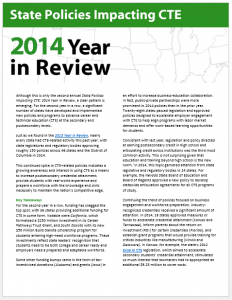Today, Achieve released two new briefs highlighting academic and CTE integration in Ohio and Massachusetts. Achieve also released a helpful compendium of its CTE resources, many of which NASDCTEc helped produce. Download the PDF compendium here.
In “Seizing the Future: How Ohio’s Career-Technical Education Programs Fuse Academic Rigor and Real-world Experiences to Prepare Students for College and Careers,†we learn about the changing face of Ohio CTE, which now focuses on integrating academics in a rigorous and relevant curriculum in high-skill, high-demand Career Clusters® and pathways and includes strong connections to postsecondary education and employers.
“Career-tech now integrates rigorous academic preparation with career education,†says Steve Gratz, senior executive director at the Ohio Department of Education and NASDCTEc member. “We are ‘mashing up’ college and career. This is a shift from the past and one that we are serious about.â€
In “Best of Both Worlds: How Massachusetts Vocational Schools are Preparing Students for College and Careers,†we learn more about state policies that promote strong programming, including the state’s college- and career-ready course of study, incentives for rigorous academic standards in its accountability system, and capacity-building support for locals. The brief also highlights some of the state’s vocational-technical schools for their impressive student outcomes.
Finally, the National Association of State Boards of Education (NASBE) has also released a new brief that examines the efforts of six states — Arkansas, Delaware, District of Columbia, Kentucky, New Jersey, and West Virginia – to modify their existing science standards or adopt new benchmarks such as the Next Generation Science Standards. It also explores each state’s unique path to adoption and implementation as well as the common strategies and activities used to engage stakeholders.
———
State Legislative Update
With more than two thirds of state legislatures adjourned for the year, CTE has had some big wins in statehouses across the country. You can catch up with our last legislative update here. In the last few weeks, there have been a few more notable developments.
- Earlier this week, Oregon lawmakers approved free tuition to its 17 community colleges through a $10 million last-dollar scholarship program similar to Tennessee’s popular initiative.
- Additionally, lawmakers appropriated $35 million for STEM and CTE-related activities, including a pilot program to increase student exposure to CTE.
- In late June, the California legislature agreed to a $115 billion budget deal – effective July 1 – that sends more than $400 million in new money to the state’s CTE programs next year. Specifically, lawmakers approved Gov. Jerry Brown’s proposed CTE Incentive Grant program to the tune of $900 million over the next three years (with $400 million for Fiscal Year 2015-16), though the state’s budget adviser cited concerns about the program back in March. This additional CTE funding follows two years and a $500 million investment in the California Career Pathways Trust, which has already awarded two rounds of competitive grant funding to partnerships among schools, community colleges, and employers to create career pathways aligned to high-need and high-growth sectors. One more CTE-related proposal, The Career and Job Skills Education Fund, is still working its way through the legislature, and is focused on results-driven CTE programs. If passed, it remains unclear how this will be funded given that, as currently proposed, it is contingent upon funds appropriated in the recently passed budget.
- Finally, Nevada and Michigan also saw significant funding bumps for CTE, middle college programs and dual enrollment.
Andrea Zimmermann, State Policy Associate



